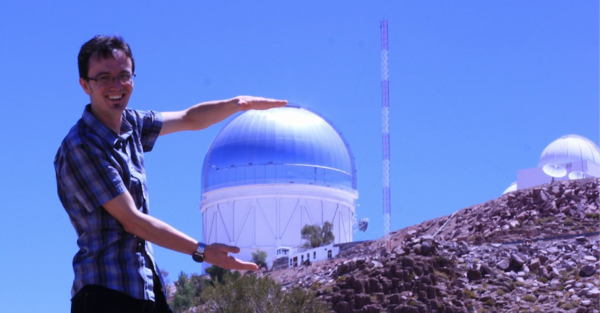

What is your role in the DESI project?
I have been working on the imaging surveys for the last 5 years or so. DESI is a survey to build a 3D map of the universe. We need to know ahead of time where to point DESI’s optical fibers to collect light from the distant galaxies that we want to map. We do this by taking regular images of the sky, building 2D maps, and measuring all the stars and galaxies in these maps. We select promising galaxy targets for follow-up with DESI based on their shapes and colors in 2D. DESI allows us to measure the all-important third dimension—redshift or distance—for these galaxies.
The cosmology goals for DESI require that we have a very uniform and well-understood set of target galaxies that we start from, and this means having sensitive images and careful measurements of the stars and galaxies they contain. No existing imaging surveys were sensitive enough, so we had to do our own! We used three different telescopes and cameras, in Chile and in Arizona, to collect all the images we need. We also use infrared images from the WISE space telescope operated by NASA.
What do you do as part of DESI?
In the early stages of this work, I was part of the team that went to the telescopes to carry out observations. All together, we spent over 1000 nights to collect these images. I love traveling to the telescopes; the secluded mountaintops are very quiet and peaceful, and the high desert terrain is starkly beautiful. Even though it’s very tiring working long night shifts, we get into the rhythm of the sky, watching sunset and sunrise, moonset and moonrise, and even the rise and set of the Milky Way galaxy.
All our imaging observations are finished now, and now we are focusing on the computer programs that detect and measure the stars and galaxies in the images. This is tricky because we have images taken in a variety of conditions—lots of clear and still skies, but some turbulent skies, and even light clouds on occasion. We need to squeeze information from all these images, so we have to take into account what the atmosphere has done to the appearance of the galaxies in each image. We’re currently working on our ninth full processing of our full image collection—Data Release 9 from the DESI Legacy imaging surveys.
In practice, I spend most of my day writing and debugging computer programs, figuring out where and why the software fails and how we can improve our processing to make the best measurements we can.
Where were you born? Where do you live now?
I was born in Squamish, near Vancouver in western Canada, and grew up in the Kootenay region, in the mountains. I did my PhD in Toronto, followed by postdoctoral work in the USA for five years, then moved back to my partner’s hometown of Waterloo, Ontario.
What would you say is the most interesting or exciting thing about your job?
I just think it’s amazing that we can measure things about galaxies that are billions of light-years away, and figure out the shape and evolution of the whole universe. Day to day, I spend a lot of time writing computer code and looking at images of galaxies, and galaxies just look amazing! Most of the galaxies we will observe with DESI are so distant that they just look like tiny smudges, but nearby galaxies are just endlessly amazing.
I also have the privilege of working with a bunch of very smart, interesting, and dedicated people every day. It takes hundreds of highly skilled and specialized people, with overlapping knowledge and interests, to make a complicated project like DESI work. I’m an expert in a tiny little corner of the project, and it’s amazing to me that we can all coordinate our little patches of expertise to build something truly amazing.
Any advice for aspiring scientists?
One of my advisors says “don’t choose what you work ON, choose who you work WITH”. That might be a little extreme, but modern observational astronomy is a large collaborative undertaking, and working with people you like and respect is one of the things that makes it really fun. Big science projects require all kinds of people, so don’t worry that you don’t know everything (nobody does!). Follow up things that seem interesting to you! Keep in mind that a lot of the science stories you see in the news are the results of years or decades of work—some days are thrilling, and some days are just a grind like any other job; persistence is really important.
Finally, what do you do for fun?
I have a family (partner plus kids ages 9 and 11) and we like to go camping and hiking and dig in our garden.